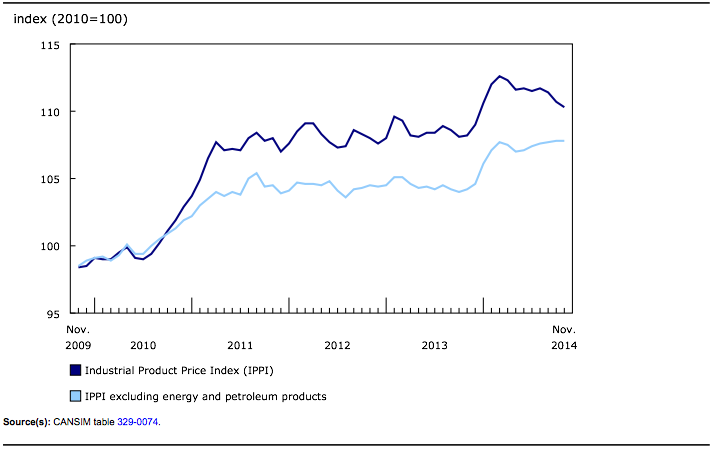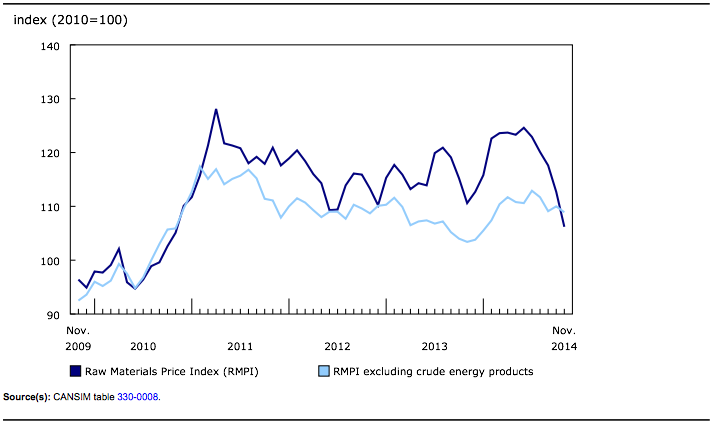Industrial Product and Raw Materials Price Indexes, November 2014

The Industrial Product Price Index (IPPI) decreased 0.4% in November, mainly because of lower prices for energy and petroleum products. The Raw Materials Price Index (RMPI) declined 5.8%, largely as a result of lower prices for crude energy products.
Chart 1: Prices for industrial goods decrease
Industrial product price index, monthly change
The IPPI declined for the third straight month in November (-0.4%), after decreasing 0.6% in October. Of the 21 major commodity groups, 5 were down, 14 were up, while 2 were unchanged.
The main reason for the decline in the IPPI was lower prices for energy and petroleum products (-2.3%). Motor gasoline (-6.2%) as well as heavy fuel oils (-11.8%) were mostly responsible for the decline in this commodity group. This was the fifth consecutive decline for motor gasoline and global supply of crude oil remained high. Higher prices for diesel fuel (+4.8%) and light fuel oils (+3.0%) moderated the decline in this commodity group as demand for heating fuels increased. The IPPI excluding energy and petroleum products was unchanged in November.
Also contributing to the decline in the IPPI were lower prices for chemical and chemical products (-1.2%). The main reason for the decline in this commodity group was aromatic hydrocarbon gases (-11.9%) and, to a lesser extent, liquefied refinery gases, and acyclic hydrocarbons not elsewhere classified (-5.4%).
To a lesser extent, primary non-ferrous metal products (-0.9%) also contributed to the decline in the IPPI in November. Lower prices for unwrought precious metals and precious metal alloys (-3.5%), specifically unwrought silver and silver alloys (-6.0%) as well as unwrought gold and gold alloys (-3.2%), were the main reasons for the decline in this commodity group. However, higher prices for unwrought aluminum and aluminum alloys (+2.3%) counterbalanced the decline.
Moderating the decline in the IPPI in November were higher prices for motorized and recreational vehicles (+0.7%). The main reason for the increase in this commodity group was higher prices for passenger cars and light trucks (+0.8%), motor vehicle engines and motor vehicle parts (+0.5%) as well as aircraft (+1.1%). The increase in the prices of motorized and recreational vehicles was closely linked to the depreciation of the Canadian dollar relative to the US dollar.
Fruit, vegetables, feed and other food products (+0.2%) also helped moderate the decline in the IPPI. Higher prices for grain and oilseed products, not elsewhere classified (+2.9%) and, to a lesser extent, flour mixes, dough and dry pasta (+0.8%) were the main reasons for the increase in this commodity group.
Some IPPI prices are reported in US dollars, and are converted to Canadian dollars using the average monthly exchange rate. Consequently, any change in the value of the Canadian dollar relative to the US dollar will affect the level of the index. From October to November, the Canadian dollar depreciated 1.0% relative to the US dollar. If the exchange rate had remained constant, the IPPI would have declined 0.6% instead of decreasing 0.4%.
Industrial Product Price Index, 12-month change
The IPPI rose 1.9% during the 12-month period ending in November, following a 2.4% increase in October.
Compared with November 2013, the advance of the IPPI was mainly attributable to motorized and recreational vehicles (+5.4%). The main reason was higher prices for passenger cars and light trucks (+5.5%), motor vehicle engines and motor vehicle parts (+4.3%) and aircraft (+9.6%).
Meat, fish, and dairy products (+11.4%) also contributed to the year-over-year increase in the IPPI, with higher prices for fresh and frozen beef and veal (+32.1%) and fresh and frozen pork (+19.1%).
The year-over-year increase in the IPPI was largely moderated by lower prices for energy and petroleum products (-5.9%). Compared with November 2013, the decline in this commodity group was mainly due to motor gasoline (-8.2%) and, to a lesser extent, heavy fuel oils (-12.4%), light fuel oils (-5.2%) and diesel fuel (-4.1%).
Raw Materials Price Index, monthly change
The RMPI (-5.8%) fell for the fifth consecutive month in November, after declining 4.2% in October. Of the six major commodity groups, three were up and three were down.
Chart 2: Prices for raw materials decrease

The decline in the RMPI was primarily due to lower prices for crude energy products (-10.6%), specifically conventional crude oil (-10.9%), which posted its largest decline since December 2008. The decrease in the price of crude oil can be partly attributed to the continued surplus in the global crude oil supply. The RMPI excluding crude energy products declined 1.0%.
To a lesser extent, lower prices for animals and animal products (-2.8%) also contributed to the decline in the RMPI. Lower prices for hogs (-13.8%) were the main reason for the decline in animals and animal products, while prices for cattle and calves (+2.3%) continued to rise.
Slightly moderating the decline in the RMPI were higher prices for crop products (+1.2%). Prices for wheat (+4.1%), canola (+3.8%) as well as other crop products (+0.3%) were the main reasons for the increase in this commodity group.
Raw Materials Price Index, 12-month change
The RMPI fell 4.0% in the 12-month period ending in November, after declining 2.2% in October.
Compared with November 2013, the decrease in the RMPI was almost entirely attributable to a 12.7% drop in the price of crude energy products. Conventional crude oil (-12.9%) was mainly responsible for the decline in this commodity group. On a year-over-year basis, the RMPI excluding crude energy products rose 5.3% in November.
The decrease in the RMPI over the 12-month period was moderated mainly by higher prices for animals and animal products (+12.9%), which have been on an upward trend on a year-over-year basis since April 2013. Live animals (+21.8%), specifically cattle and calves (+43.1%) and, to a lesser extent, hogs (+10.9%), were the main source of the increase in this commodity group.
To a lesser extent, prices for metal ores, concentrates and scrap (+1.9%) also contributed to the year-over-year increase in the RMPI. The increase was led by higher prices for waste and scrap of metal (+10.7%), while lower prices for iron ores and concentrates (-41.2%) moderated the increase in this commodity group.
Source: Statistics Canada, http://www.statcan.gc.ca/daily-quotidien/150106/dq150106a-eng.htm?cmp=mstatc.










